
Technical Information
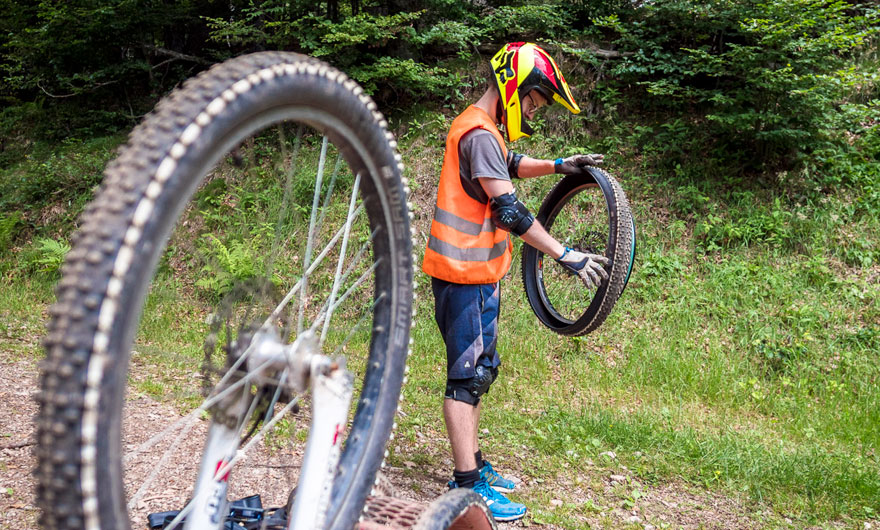
Our off-road and downhill scooters have been specially designed by us for a gravity driven descent, and differ greatly from usual pedal scooters. The forces the scooters are subjected to are high, due to the nature of the scooter track which consists of prepared forest routes rather than tarmac roads. A further challenge is posed by the scooter track’s length, being 8km long with an altitude difference of 750m, which makes it the longest scooter track in Europe.
The scooters are well suited to off-roading by having large wheels to keep the required distance from the ground, stable heavy frames with hydraulic front suspension and high performance front and rear brakes, all of which make them less suited to riding on horizontal roads.
Thanks to many years of optimisation with countless modifications we have now reached the point where the downhill scooters are perfect and reliable. Our sophisticated maintenance technique plays a decisive role. The large amount of wear and tear means wheels, inner tubes, brake pads and brake discs wear out quickly! The costs of such replacements contribute significantly to the price of a scooter trip, alongside the costly maintenance of the scooter track itself. In addition, we have to pay an annoying amount of rent for the use of the forest roads to the Municipal Forestry Office, although the maintenance and repair of the scooter route is at our expense.
A scooter costs over 1600 €, here is the technical information:
- Frame: SOLID BIKES DH-Scooter, Steel CroMo
- Suspension fork: Marzocchi Dirt Jumper 3 (Spring deflection 100mm)
- Handlebars: TRUVATIV Husselfelt
- Front wheel brake: Quad QHD-1 Rotor 180mm
- Rear wheel brake: Quad QHD-1 Rotor 203mm
- Front wheel/ impeller: 26″ REVERSE VR 9mm
- Rear wheel/ impeller: 26″ REVERSE VR 9mm
- Tyres SCHWALBE Smart Sam
- Total weight: 18kg
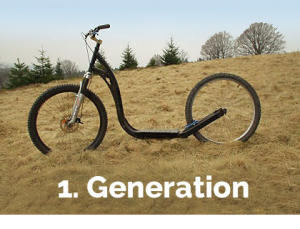
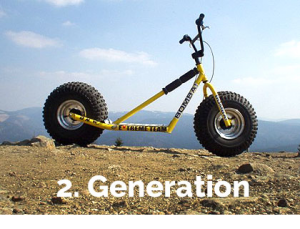
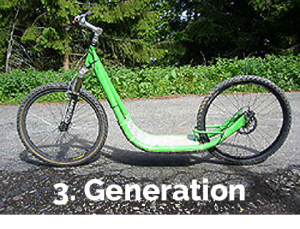
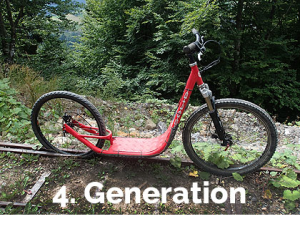
Some Scooter Physics
Thanks to the low centre of gravity on our downhill scooters, much higher lateral acceleration can be achieved than with most bicycles. Coupled with an overestimation of one’s own ability and reduced traction due to long dry spells, this can lead to dangerous situations. The two high performance brake discs are specifically suited to the length and altitude difference of the Downinsland Scooter Track and allow the scooter to be stopped safely. The inclusion of hydraulic brake discs on the front and rear wheels differs from a conventional braking system and they can be operated independently of one another just as on a motorbike. The good grip of the off-road tyres and sensitive metered braking, particularly on the front wheel, increase safety.
Correct braking
Even the best brakes will be overwhelmed by unsuitably excessive speed. The resulting ‘panic braking’ then often may lead to an accident. Excessive braking of the lightly loaded rear wheel together with the partly reduced grip on dry forest paths (mainly fine grained, no coarse gravel) causes a strong reduction in the braking action. To beginners, this may feel like brake failure. This type of braking is even worse when combined with a strong braking of the front wheel, which may be blocked this way and mostly leads to a fall.
In hydraulic disc brakes, the braking effect is only diminished when subjected to a considerable overload (completely false driving technique, continuous braking in conjunction with high body weight) which boils the brake fluid. This effect known as “fading” occurs only rarely and manifests in a need to press the brake lever further. By pressing the brake lever shortly and strongly, several times if necessary, the braking effect is restored. Immediately afterwards it is necessary to
pause for around 5 minutes and allow the overheated brake discs to cool down. The brake discs are so powerful that the scooter can even be stopped with just one brake. For this reason, please make yourself familiar with the front brake at the start of the scooter trip in section 1. By working the brake carefully, you can avoid locking the front wheel.
Incidentally, a scooter ride with “continuous use of the rear brake and thereby a partially locked rear wheel” is torture for brakes and tyres, even aside from the poor braking effect. Occasional release of the brakes allows the brake to cool. If this does not happen, the brake discs need to be replaced after just one ride! This is avoidable, causes additional costs and is one of the reasons for the implementation of a maximum weight limit. As should be generally known, the optimal braking action is reached just before locking the wheel, just like in a car.
